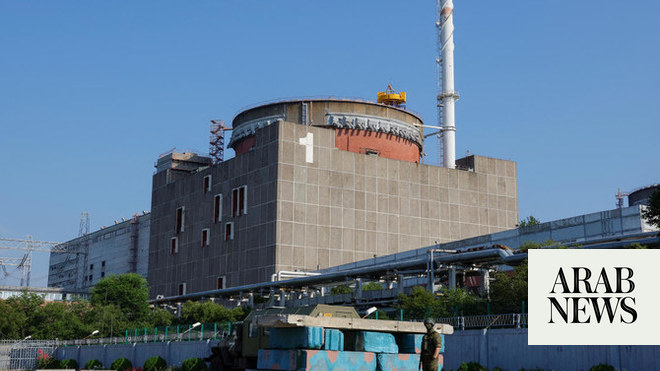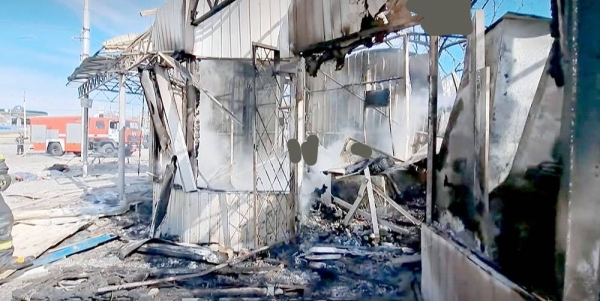
A detailed plan has been drawn up by Russia to disconnect Europe’s largest nuclear plant from Ukraine’s power grid, risking a catastrophic failure of its cooling systems, the Guardian has been told.
World leaders have called for the Zaporizhzhia site to be demilitarised after footage emerged of Russian army vehicles inside the plant, and have previously warned Russia against cutting it off from the Ukrainian grid and connecting it up to the Russian power network.
But Petro Kotin, the head of Ukraine’s atomic energy company, told the Guardian in an interview that Russian engineers had already drawn up a blueprint for a switch on the grounds of emergency planning should fighting sever remaining power connections.
“They presented [the plan] to [workers at] the plant, and the plant [workers] presented it to us. The precondition for this plan was heavy damage of all lines which connect Zaporizhzhia nuclear power plant to the Ukrainian system,” Kotin said in an interview on Ukraine’s independence day on Wednesday, with the country mostly locked down because of the threat of Russian attacks.
He fears that Russia’s military is now targeting those connections to make the emergency scenario a reality. Both Ukraine and Russia have accused each other of shelling the site.
“They just started doing that, they starting all the shelling, just to take out these lines,” Kotin said.
Other threats to nuclear security at the plant include vehicles packed so tightly into turbine halls that firefighters would struggle to access them if a fire broke out, and a campaign of terror against workers who have chosen to stay at the frontline plant.
One was beaten to death, and another so severely injured that he needed three months to recover. More than 200 have been detained, Kotin said.
The plant’s electricity connections are already in a critical situation, with three of the four main lines connecting it to Ukraine’s grid broken during the war, and two of the three back-up lines connecting it to a conventional power plant also down, he said.
The Russian plan to disconnect it entirely would raise the risk of a catastrophic failure by leaving it dependent on a single source of electricity to cool the reactors. “You cannot just switch from one system to another immediately, you have to … shut down everything on one side, and then you start to switch on another side,” he said.
During a shift between grid systems, the plant would be reliant only on a back-up diesel-powered generator, with no further options should that fail. After only 90 minutes without power the reactors would reach a dangerous temperature.
“During this disconnection, the plant won’t be connected to any power supply and that is the reason for the danger,” he said. “If you fail to provide cooling … for one hour and a half, then you will have melting already.”
Russia seized control of the Zaporizhzhia plant in March but it is still run by Ukrainian workers. There has been increasing alarm about Russian management of the site in recent weeks, and pressure on Moscow to allow UN inspectors to visit.
Kotin said inspectors from the UN’s nuclear watchdog could be at the plant within one or two weeks to check on security, after progress in negotiations with Russia about a visit by the International Atomic Energy Agency (IAEA).
Kotin is also concerned about the fire risk from vehicles packed into the turbine halls, which sit next to the two reactors still in operation. There are 14 trucks in one hall, and at least six in another, sources at the plant have told him.
“In case there is a fire in the turbine hall you don’t even have a possibility to put it out or mitigate the consequences of this fire, because your fire brigades cannot get in, because any entry is blocked by the trucks, which are just packed in there,” he said.
Any blaze could then potentially spread towards the reactor buildings, where a fire would have disastrous implications far beyond the immediate region.
“This situation is very dangerous not only for the plant, for Ukraine, but also for the whole world because you never can say what the weather would be like and what the wind direction [would be].”
Many other military vehicles are lined up under overpasses, built to house pipes and walkways between reactor and turbine complexes, Kotin said, perhaps to provide protection from drones.
He praised about 9,000 workers who are still on duty at the plant, from a prewar workforce of about 11,000. Many evacuated their families but stayed at their posts because of the need for a skilled team to operate it.
Modernisations to Ukraine’s nuclear plants in the wake of the Chornobyl disaster means that although the plant was built to Soviet specifications, Russian engineers don’t have the skills to operate it.
“Actually, for us they are heroes, just doing their job in such unbelievable conditions,” said Kotin, who knows the plant, and its workers well because he spent most of his career there. He arrived as a young graduate and rose to become general manager.
Rockets have also landed within two dozen metres of 174 spent fuel containers housed at the plant, which would be more vulnerable to weapons than the reactors, which are built to withstand the impact of a passenger jet.
“It will probably withstand two explosions of maybe two missiles on one container and after that, it will be broken,” he said. “Actually we had a rocket came in just 10, 20 metres just from the site [where the containers are stored].”
However, Kotin said that he hoped nuclear inspectors would be able to visit the Zaporizhzhia plant within “one, maybe two weeks”.
“There is progress in negotiations … there is only modalities of the mission to finally agree between parties, and after that they will go. And actually I’ve seen some plans that they are to go at the end of the month.”
He said he also had confidence that Ukrainian workers who have sacrificed so much for the plant would be able to keep it safe.
“In any case, we won’t allow Russians to bring the world to the nuclear catastrophe and we will do everything just to return the plant to under our full control and operate it safely reliably, like it always been.”












